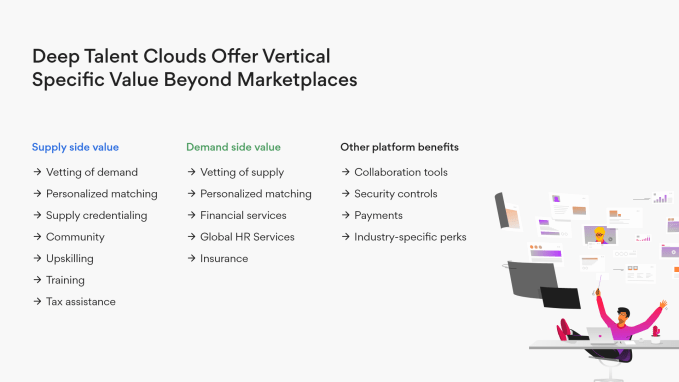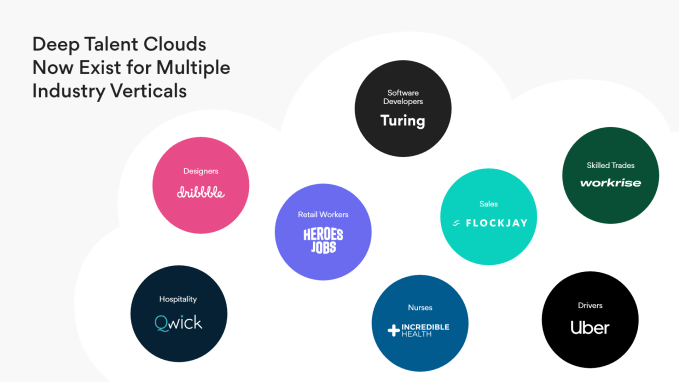By Jonathan Siddharth, CEO and Co-founder of Turing.com.
The world has changed…
Silicon Valley may still be the best place to start a company, but if you’re a founder, it’s now financially reckless to scale your company in the Bay Area.
There has been a massive shift in how we build tech companies.
“The old way to hire was by finding people that live <20 miles from your office. The new way is by finding the best people in the world, regardless of where they live. Post-Covid, boundaryless hiring has accelerated.”
Boundaryless companies are now the new normal — and this transformation calls for a new way to build companies with a globally distributed workforce.
In this post, I’ll talk about 3 tailwinds that have accelerated the growth of remote-first companies. Then, we’ll dig into the big problems and opportunities that exist. Finally, I’ll explain why the “Deep Talent Cloud” is a helpful way to think of this new category.
Every company is now a remote company (to some degree or the other)
Covid has accelerated the shift to remote work. Nicholas Bloom, a Ph.D. economist from Stanford, says 70% to 90% of office workers don’t want to return to a physical workplace full time. Covid has shown us that nearly every job can now be remote. Nobody cares where you live anymore. The new default is “Work from anywhere + meet as needed.”
It’s easier (& cheaper) than ever before to find remote talent
Accessibility to online courses through platforms (e.g., Coursera, Udacity, etc) has democratized access to high-quality education, resulting in more talented and well-trained individuals all over the world. At the same time, competition in tech hubs (i.e., Silicon Valley) has made it increasingly costly and time-consuming to recruit talent. This makes it possible to hire individuals with Silicon Valley level skill-sets from a broader, more diverse pool with excellent retention.
SaaS tools for distributed teams have come a long way:
Innovative collaboration tools have enabled distributed teams to perform on par with co-located teams. Github, Slack, Zoom, Trello, etc., did not exist more than 15 years ago. For the first time in history, it’s possible to recruit and collaborate with talented people from anywhere in the world.
Companies that remain co-located are finding it hard to attract great people:
A recent survey conducted by Blind, an anonymous survey firm, queried 3,000 employees from companies including Apple, Amazon, Microsoft, Google, Facebook, Goldman Sachs, and JPMorgan. They asked if employees prefer to work from home permanently or get a $30,000-a-year raise. 64% percent responded that they would rather work remotely than get the raise. It’s going to be an uphill battle for companies unwilling to embrace remote-first policies to hire and keep top-tier talent.
What’s stopping every company from going Remote-First?
Three main obstacles stand in the way of companies that want to go remote-first.
1. It’s hard to find Silicon Valley caliber people who are remote
It’s easy to find cheap remote talent. You can go to several open labor marketplaces and bid for developers or, you can find a dev shop. The problem is quality because in many marketplaces, there is no vetting.
2. Evaluating global professionals is hard
If you’re hiring a developer from Sao Paulo, Brazil, you won’t see Stanford or Berkeley in her educational experience. What’s the Stanford of Brazil? You won’t see Google, Facebook, etc., on a resume either. The individual you hire could be your next 10X engineer, but it’s hard to evaluate based on a resume alone. Without deep knowledge of that geography or its recruiting playbook, it can be hard to recruit efficiently.
3. Managing remote teams is hard
What’s the biggest reason a remote collaboration fails? If you ask any engineering or product leader, you’ll likely hear that it’s due to challenges with communication and timezones.
The nuts and bolts of running a globally distributed team are not easy. It’s painful to manage international payments. It’s complex to handle Global HR correctly from a compliance and worker classification perspective, and it’s pretty challenging to stay fully compliant with international labor laws.
“For these reasons, we are seeing the birth of a new category—the Deep Talent Cloud.”
(Thin) Labor Marketplaces are dead. The Deep Talent Cloud has replaced them.
Amazon Web Services (AWS) made it easy to push a button to bring up elastic resources in the cloud for computing and storage. Talent Cloud is a category of companies that make it easy to push a button to bring up teams in the cloud.

Image Credits: Turing (opens in a new window)
A labor marketplace is a jack of all trades and a master of none. A talent cloud is vertically focused and precise, making it capable of delivering candidates that have been deeply evaluated for that specific industry/vertical. Deep talent clouds are often SaaS-enhanced to offer additional value to both sides of the marketplace. For example, my company Turing is an intelligent talent cloud focused on software developers as a vertical. There are very effective talent clouds being built for other verticals.
Labor marketplaces have been around for several years. You’ve probably used them to hire people, and you may have used them to find work. The problem with labor marketplaces is that they do very little beyond connecting the two sides of demand and supply. This means that they are not tailor-made for a specific vertical. Instead, they are suitable for small, gig-based work that’s relatively low stakes.
Thin marketplaces were okay for an era where office-based work was the default, and remote work was a fringe use case. In today’s remote-first era, what’s needed is a Deep Talent Cloud. Deep Talent Clouds go well beyond simply connecting both sides of a marketplace. They may offer other features such as:
- Supply vetting
- Demand vetting
- Collaboration tools
- Security controls
- Training/upskilling
- Supply Credentialing
- Community
- Financial Services,
- Insurance
- Payments
- HR Services
- Tax assistance
- Industry-specific perks
Marketplaces are broad. Deep Talent Clouds are focused on specific industry verticals.

Image Credits: Turing (opens in a new window)
For example:
- Sales – Flockjay
- Software developers – Turing
- Oil & Natural Gas – WorkRise
- Nurses – Incredible Health
- Design – Dribbble, Behance
- Marketing – Publicist
- Drivers – Uber, Lyft
Deep Talent Clouds are SaaS-enabled
The SaaS tools might be first-party or third party. Companies such as OysterHR, Panther.co, Remote.com and Deel are examples of companies that offer excellent SaaS solutions to solve problems like global HR, payments, etc. Collaboration tools like Miro, Mural, etc., make remote professionals more efficient. There are also vertical-specific SaaS tools like Invision that make design collaboration more effective.
The future of work is remote
Every company that adapts to being a remote-first company will have an unfair edge in recruiting, retention, speed of execution, and financial efficiency. We are entering the golden era of remote work. Luckily there’s a large and growing ecosystem of companies making that happen before our very eyes. The future of work is Boundaryless.
About Jonathan Siddharth:
Jonathan is the CEO and Co-founder of Turing.com. Turing is an AI platform that lets companies “push a button” to hire and manage remote developers. Turing has raised more than $55 Million from WestBridge Capital, Foundation Capital, Adam D’Angelo and execs from Google, Facebook, Twitter etc.
Before starting Turing, Jonathan was an Entrepreneur in Residence at Foundation Capital, following the successful sale of his first AI company that he co-founded while at Stanford.
You can find Jonathan on Twitter and LinkedIn.